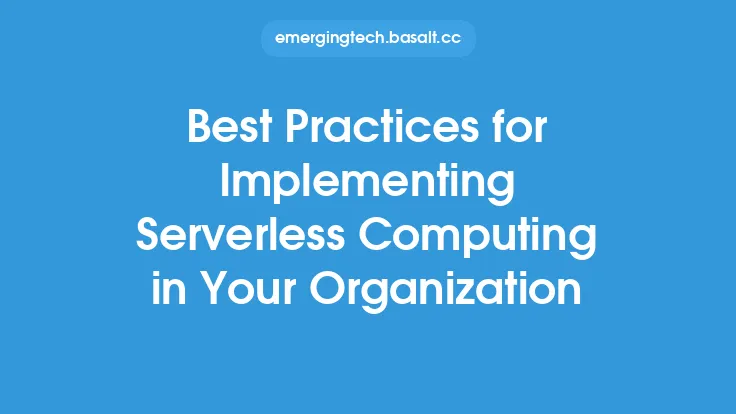Implementing cryptography in an organization is a complex task that requires careful planning, execution, and maintenance. Cryptography is a critical component of cybersecurity, and its proper implementation is essential to protect sensitive data and communications. In this article, we will discuss the best practices for implementing cryptography in an organization, focusing on the key aspects that are essential for a successful deployment.
Key Considerations for Cryptography Implementation
Before implementing cryptography, it is essential to consider several key factors. These include the type of data to be protected, the level of security required, and the computational resources available. The choice of cryptographic algorithm and protocol will depend on these factors, as well as the specific use case and requirements of the organization. For example, symmetric encryption algorithms like AES are suitable for bulk data encryption, while asymmetric encryption algorithms like RSA are better suited for key exchange and digital signatures.
Cryptographic Key Management
Cryptographic key management is a critical aspect of cryptography implementation. Keys must be generated, distributed, stored, and managed securely to prevent unauthorized access. This includes key generation, key exchange, key storage, and key revocation. A well-designed key management system should include features like key rotation, key expiration, and key revocation lists (KRLs) to ensure that keys are updated and revoked regularly. Additionally, keys should be stored securely, using techniques like encryption and access control, to prevent unauthorized access.
Secure Protocol Implementation
Secure protocol implementation is another critical aspect of cryptography implementation. Protocols like TLS, IPsec, and PGP must be implemented correctly to ensure secure communication. This includes configuring protocol parameters, like cipher suites and key exchange protocols, and ensuring that the protocol is used correctly in the application. For example, TLS should be used with a secure cipher suite, like AES-GCM, and a secure key exchange protocol, like Elliptic Curve Diffie-Hellman (ECDH).
Cryptographic Module Validation
Cryptographic module validation is essential to ensure that the cryptographic implementation is correct and secure. This includes testing the cryptographic module against standards like FIPS 140-2 and NIST SP 800-90A. Validation should include testing of the cryptographic algorithms, key management, and protocol implementation to ensure that they meet the required standards. Additionally, the cryptographic module should be regularly updated and patched to ensure that any vulnerabilities are addressed.
Side-Channel Attack Protection
Side-channel attacks, like timing and power analysis attacks, can compromise the security of a cryptographic implementation. To protect against these attacks, techniques like constant-time implementation, blinding, and masking should be used. For example, a constant-time implementation of a cryptographic algorithm can prevent timing attacks, while blinding and masking can prevent power analysis attacks.
Secure Coding Practices
Secure coding practices are essential to prevent vulnerabilities in the cryptographic implementation. This includes using secure coding techniques, like secure memory allocation and deallocation, and secure coding libraries, like OpenSSL. Additionally, code reviews and testing should be performed regularly to ensure that the code is secure and correct.
Compliance and Regulatory Requirements
Compliance and regulatory requirements, like PCI-DSS and HIPAA, must be considered when implementing cryptography. These requirements often specify the use of specific cryptographic algorithms and protocols, like AES and TLS, and require regular security audits and testing. Additionally, compliance and regulatory requirements may require the use of specific key management practices, like key rotation and key expiration.
Cryptography Implementation in Cloud and Virtual Environments
Cryptography implementation in cloud and virtual environments requires special consideration. Cloud providers often offer cryptographic services, like key management and encryption, that can be used to protect data in the cloud. However, the use of these services must be carefully evaluated to ensure that they meet the required security standards. Additionally, virtual environments, like virtual machines and containers, require special consideration to ensure that the cryptographic implementation is secure and correct.
Best Practices for Cryptography Implementation
To ensure a successful cryptography implementation, several best practices should be followed. These include:
- Using established cryptographic protocols and algorithms, like TLS and AES
- Implementing secure key management practices, like key rotation and key expiration
- Using secure coding techniques, like secure memory allocation and deallocation
- Regularly testing and validating the cryptographic implementation
- Staying up-to-date with the latest security patches and updates
- Considering compliance and regulatory requirements, like PCI-DSS and HIPAA
- Evaluating the use of cloud-based cryptographic services, like key management and encryption
Conclusion
Implementing cryptography in an organization is a complex task that requires careful planning, execution, and maintenance. By following the best practices outlined in this article, organizations can ensure a successful cryptography implementation that protects sensitive data and communications. This includes considering key factors like the type of data to be protected, the level of security required, and the computational resources available, as well as implementing secure key management, protocol implementation, and coding practices. Regular testing and validation, as well as staying up-to-date with the latest security patches and updates, are also essential to ensure the security and correctness of the cryptographic implementation.





